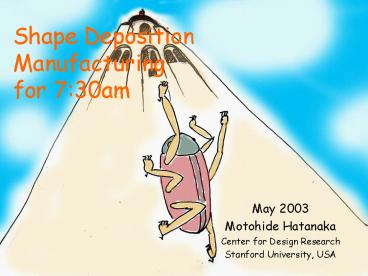Shape Deposition Manufacturing for 7:30am - PowerPoint PPT Presentation
1 / 45
Title:
Shape Deposition Manufacturing for 7:30am
Description:
Bonding weakness (same as ) Delamination in composite structures. High curing temperature ... VI. Pre-encapsulation. 38. Available process options. 39. Reasons ... – PowerPoint PPT presentation
Number of Views:255
Avg rating:3.0/5.0
Title: Shape Deposition Manufacturing for 7:30am
1
Shape Deposition Manufacturingfor 730am
- May 2003
- Motohide Hatanaka
- Center for Design Research
- Stanford University, USA
2
http//www.lib.utexas.edu/maps/world.html http//w
ww.geneve-tourisme.ch/ http//www.jnto.go.jp/eng/R
TG/RI/index.html
http//www.u-tokyo.ac.jp/ http//www.stanford.edu/
3
The Biomimetic Robotics lab
We value experience. Even being cockroaches.
4
Grammatical introduction
Shape Deposition Manufacturing
(Deposit-and-Shape Manufacturing)
5
Repetitive machining and deposition
6
Animation!
7
Cyclic deposition and shaping
Prepare mold block
Machine mold
(place component to embed)
Deposit material
Shape mold/part
Extract part
8
SDM capabilities
Multi-material molding
Component embedding
9
Part number reduction
Left Kinematic prototype of stroke extension
linkage with 31 parts Center Single component
SDM linkage with thick flexures Right SDM
linkage with thin fabric-reinforced flexures
(2001)
10
SDM merits
robustness
No fasteners
easy to automate
Arbitrary shapes
11
What weve embedded
- Servo motors
- pneumatic pistons
- sensors
- Printed circuit board
- flexible printed circuit (Cupolyimide)
- electrical wiring
- electrical connectors
- springs
- fabric (cotton, polyester, etc)
- strings (cotton, polyester, etc)
12
Embedded sensor example (continued)
A batch of four parts during the final machining
step. Part material is urethane (yellow).
Sacrificial support material is wax (red),
filling cavities and encasing the circuit leads
to protect them.
Completed pressure sensor unit ready for
connection to a pneumatic actuator.
Fabrication instructions archived at
http//cdr.stanford.edu/dml/biomimetics/documents
.html
13
Example embedded actuators
Antagonist electric motors with cable
tendons. Photo taken after machining, half way
through build sequence
14
Embedded actuator example contd
Shaping structures are machined a pallet on a
CNC mill
Deposition part and support materials are cast
in place, after each machining stage
15
Undercut with sacrificial material. Top shaping
by machining.
Primitive
Compact set
Compact precedence graph
16
Limitations/requirements
- Mold size maximum part size (approximately
300 x 300 x 150 mm) - Mostly serial process (Plastic curing time
24 hours) - Materials Small shrinkage (e.g. polyurethane,
epoxy, silicone)
17
Materials we use
- Polyurethane (soft, medium, hard)
- Silicone
- Epoxy
- Wax (temporary sacrificial material)
- Water soluble wax (also sacrificial)
- We will be trying
- Conductive polymer/elastomer
18
Design guidelines
- Minimize number of material castings
- Ensure machining tool accessibility
- Consider material compatibility, machinability,
and casting order - Soft materials, usually, can only be machined
with high speed fly cutters. - Consider using larger tools for faster machining.
(Doubling tool diameter can speed up material
removal by x8!)
19
Problems experienced
- Bubble formation in polymer (esp. PU)
- humidity in atmosphere
- insufficient degassing
- material combination (casting soft polyurethane
on hard polyurethane ?) - chemical reaction with adhesives
- Difficult to machine soft materials
- Bonding weakness (same as ?)
- Delamination in composite structures
- High curing temperature
20
Remember this cycle!
21
(No Transcript)
22
More animation?
23
And more?
24
Still more?
25
OK, this is the last animation.
26
(No Transcript)
27
Design and fabrication of compact mechatronic
systems by shape deposition manufacturing
28
Biology is a target for complex integrated
structures manufacturing
29
Cross-boundary embedding
Application electrical wiring, structural
reinforcement, fiber optics, plumbing
30
Cross-boundary embedding difficulties
1. Secure fixturing 2. Insert obstruction/damaging
in selective processes 3. Stress
concentration
31
Types of fabrication processes
Bulk deposition (e.g. molding/casting) Bulk
removal (e.g. dissolving)
Selective deposition (e.g. fused
deposition) Selective removal (e.g. machining)
32
Selective deposition of sacrificial material
33
Selective deposition of part material
34
Four main methods of cross-boundary embedding
I. Selective deposition of part
material II. Selective removal of part
material III. Selective deposition of
sacrificial material IV. Selective removal of
sacrificial material
35
Psuedo-boundary formation
Bulk deposit material A and machine Place
insert Bulk deposit material B
36
Pre-encapsulation
Place pre-encapsulated insert in mold Bulk
deposit material A Selective remove material
A Bulk deposit material B
37
Alternative methods
V. Pseudo boundary formation VI.
Pre-encapsulation
38
Available process options
39
Reasons to choose an alternative method
40
Prioritization for cross-boundary embedding
41
Manufacturability consideration
42
Summary of work up-to-date
Motivation Build complex integrated mechanisms
as in biology
Key technology Cross-boundary embedding
Success in preliminary attempts
Process characteristics identification
43
Design guidelines
44
Possibilities to be explored
- Controlled material deposition as in many rapid
prototyping technologies (e.g. ink jet) - Tools to facilitate manual selective processes
(e.g. fine wax deposition gun) - Material-property dependent selective deposition
and removal (e.g. crystallization, chemical
etching)
45
Other challenges for realizing compact integrated
structures
- Three-dimensional electrical wiring for power and
signal transfer. - Three-dimensional plumbing for hydraulic,
pneumatic, and fuel distribution. - Development of optimal function-integrated
structures, e.g. fuel-cell-integrated skeleton.































